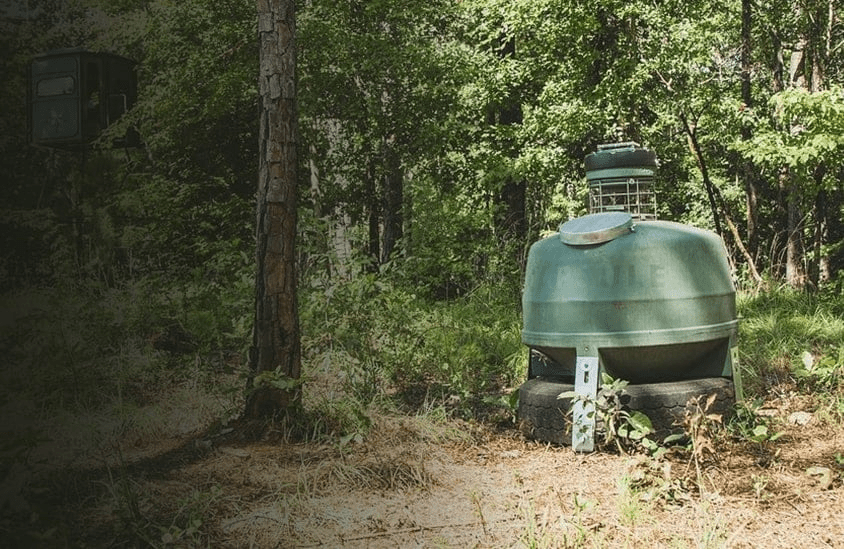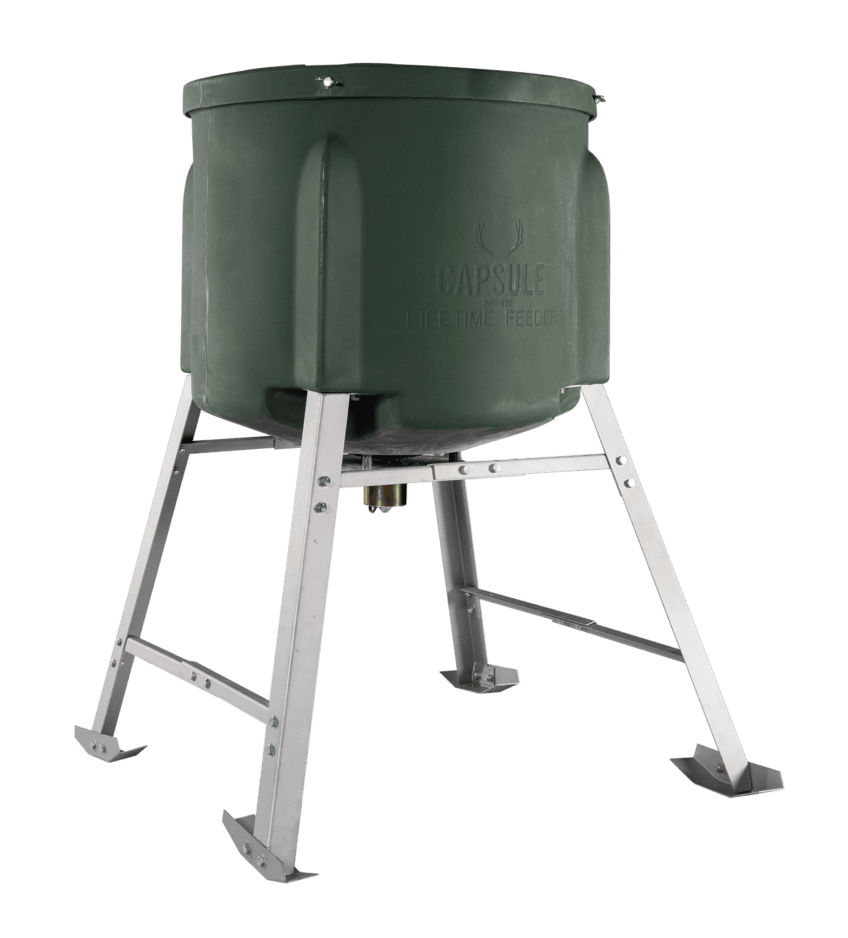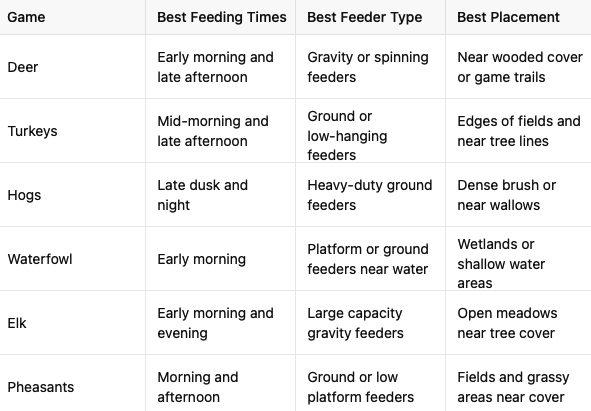Whether you hunt with a bow, crossbow, rifle, or handgun, one factor is constant: you have to be able to locate the game. It’s a known fact that most types of game will return to a location with a reliable source of nutrition. With herbivores, that could be a patch of vegetation that bears fruit or seeds. For carnivores, it’s wherever they can find prey.
Game feeders can establish a nutrition source location for the local wildlife. From your perspective, it’s like hunting a watering hole or a deer path — only you get to decide the location. But there’s a lot to know about using a game feeder. This article will discuss the nuances of using a game feeder to draw prey and make a few recommendations about which feeders are best for you and how to deploy them.
Types of Feeders
There are really no perfect types of feeders, but some feeders are better solutions for particular situations than others.
Gravity Feeders
These have a relatively simple design, and they do not require a power supply. While they are cheap and effective, there is no mechanism to time the rate of feeding. The food is dispensed until the feeder is empty. These feeders may be a good solution for areas with low wildlife pressure.
Spinning Feeders
These feeders allow you to control feeding times and amounts, but they do require a power source. You can use a timer or operate them remotely.
Trough Feeders
A trough feeder is a relatively simple design that allows multiple animals to feed at the same time. Trough feeders are simple, durable, and can be used for many different species of herbivores.
Hanging Feeders
Hanging feeders are also extremely versatile, which means that you can use them in a wide variety of terrains. They’re portable, and the fact that they’re off the ground makes them more difficult for unwanted pilfering by rodents and other small animals.
Smart Feeders
These feeders can help you monitor and control the feeder remotely. They may include features like the ability to record animal activity, measure food levels, change food release times, etc.
Attracting Specific Game Species
Naturally, the food you bait your feeder with should closely match your prey’s diet. For example, deer are drawn to high-protein feeds, particularly when their antlers are growing in the spring and summer or when does are pregnant and nursing. You may want to consider soybeans, alfalfa, cottonseed, or corn. You can increase the attraction with apples, acorns, or peanuts.
Hogs, on the other hand, are drawn to corn, which is both affordable and easy to pack into the feeder. You’ll want to place your feeder in areas with dense cover to match the areas where hogs forage.
Not only is it essential to get the feed right, but you also need to think about smart placement. Where do the animals seek food? Turkeys, for instance, are most comfortable feeding near open fields or near the edges of wooded areas, where they can seek refuge if they’re threatened. If you’re hunting ducks or geese, you would need to set your feeder at a location close enough to the water to encourage target game.
The closer you’re able to match the animals’ natural experience, the more successful you’ll be. That means understanding what the local game eats, the times of year that their diet changes, and the scents that attract them.
Choosing the Right Feed
While you’re overriding consideration should be the animal’s dietary preference, you need to consider other factors when selecting feed. Here are a few additional things to consider:
Seasonal Variations
Animal diets change with the season and climate. For example, deer prefer high-protein diets during the warmer months but are more attracted to carbohydrates as winter approaches. This enables them to live off their fat reserves when food is more scarce.
Terrain
If you’re slogging through some tough terrain, you need to consider the bulk of your feed. 50 pounds of feed can add a lot of weight to your packs, even if you’re breaking it up among your party. This may also be a deterrent for large trough feeders.
Purity
It’s important to consider the wildlife population. Avoid food with additives that may hinder the game’s ability to repopulate after hunting season.
Quantity
Overfeeding the population can interfere with healthy animal instincts and can make them dependent on the bait station for food.
Placement Strategies
As is the case with every other factor in hunting with a game feeder, placement depends on your prey, the type of feeder you’re using, the terrain, and the time of year you’re hunting.
Cover
For most types of prey, you will need to place your feeder either in or near cover. This could be 10 to 20 yards from a tree line or near low brush for smaller game. However, you’re still going to want a clear shot, so keep that in mind when you’re selecting the feeder location and your hide.
Trails
Animals tend to follow the same well-worn paths on the way to food and water sources. Placing a feeder along the way offers them an attractive alternative.
Accessibility
Place your feeder where the animals are comfortable eating from it. For example, deer and wild turkeys prefer feeding close to the ground. This is also the case with hogs, but they prefer denser brush, which could hinder your line of sight. Of course, waterfowl feeders need to be placed near wetlands. One of the disadvantages of placing ground feeders is that they may also be accessible to vermin and other animals, which can deplete your feed supply.
Distance
Hauling a feeder can be a challenge, but if you don’t put it deep enough into the terrain, animals may avoid it. Make sure you’re several hundred yards away from human activity. Avoid roads, hiking trails, housing, and businesses.
Use Water Sources
Game is used to finding food close to water sources and will inevitably go toward them. Place your feeders near watering holes or on the paths leading to them.
Separate Multiple Feeders
If you intend to use multiple feeders, separate them by 100 to 200 yards for maximum effectiveness.
Predators
The animals that your feeders attract may draw predators. Place your feeders near escape paths so the game feels that they can flee at the first sign of danger.
Timing and Frequency of Feeding
If you’re using a gravity feeder or a trough, you may not have a choice about the timing or frequency of feeding. The animals will eat your feed until it’s gone. Smart feeders can give you the ability to time the feeding.
Your feeding times should align with the eating habits of your potential prey. For deer, you should set your feeder 30 minutes before sunrise and an hour before sunset. Hogs are nocturnal, so their feeding times are during the dark hours. Whatever you’re hunting, learn about their peak feeding times. Also, consider seasonal differences in the time of day that your prey eats. For instance, many animals eat more in the fall. Some prey will eat during the warmest part of the day during the winter.
Maintenance and Refilling
Gravity feeders and troughs require the least maintenance since they don’t need a power source. Some feeders use solar panels and rechargeable batteries to minimize maintenance trips.

Refilling your feeder depends on the volume of the feeder, frequency of feeding, and the amount your feeder dispenses at each time. Smaller feeders (5 to 10 gallons) may be easier to load, but they will need to be refilled every one to two weeks. With all other factors being equal, you can determine your refill frequency based on size. For instance, a 10-gallon feeder has to be refilled twice as frequently as a 20-gallon feeder.
A typical automatic feeder will release one or two pounds of feed at a time. The final factor is the number of times per day you release food. Remember that seasonal feeding adjustments will change your restocking schedule.
Preventing Non-Target Animals
If you put out food, it’s going to appeal to a wide range of animals. Your intended target may be deer, but their food will appeal to rodents, birds, and other small animals. Additionally, predators may track prey to the location of your feeder.
One solution is a hanging feeder. Squirrels and rats may still be able to reach it, but it will make it more difficult for multiple animals to access it at once. There are also a number of commercially available guards that prevent animals from accessing the storage area of the feeder.
This large Capsule Feeder is designed to prevent animals from accessing the food between time releases.

Legal Regulations and Guidelines
Before you invest in a game feeder, you should research the local laws and regulations that might affect placement. This is particularly true if you hunt on public land where feeders may be prohibited. For example, some jurisdictions may prevent feeding stations. Particularly in ecologically sensitive areas or in regions with endangered species.
Make certain you acquire the necessary permits before purchasing a feeder or deploying it.
Game Feeding Recommendations

This comparison chart is meant to be used as a guideline. You may make different selections based on your knowledge of the seasonality, terrain, conditions, and the game you’re hunting.
Wide Selection of Game Feeders
If you’re considering adding a game feeder to improve your hunting environment, FeraDyne can help. Shop our wide selection of rugged feeders today!
